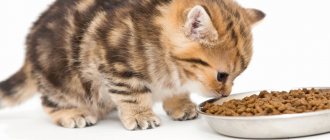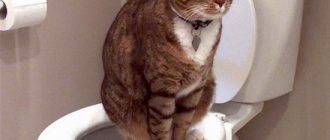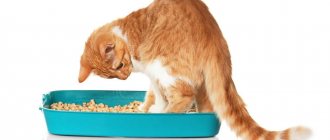Cats are susceptible to systemic failures, diseases, and pathologies. To make a diagnosis that will help the veterinarian establish the root cause, degree, stage of the disease, various diagnostic methods and tests are prescribed. For example, if a cat has difficulty urinating, the pet experiences pain when defecating, or the urine has a color that is not typical for a healthy cat, the veterinarian should conduct a urine test. Therefore, we will consider how to collect urine from a cat for analysis, in which cases a urine analysis is required.
In what cases is it necessary to submit a cat's urine for analysis?
A urine test is taken from a cat:
- if you suspect urolithiasis (urolithiasis);
- if cats have problems urinating;
- painful act of urination;
- unpleasant, specific smell of feces;
- suspicion of viral, bacterial infections;
- kidney diseases (acute, chronic);
- change in urine color;
- presence of bloody substances;
- poisoning, intoxication;
- differential diagnosis when it is difficult to make a diagnosis.
Note that the results of urine tests provide more reliable information than, for example, changes in the animal’s body based on blood tests and serological studies.
How to properly collect urine
If urine collection is done at home, then for analysis it is better to use a portion of urine that accumulates in the bladder over a long period. Therefore, the best time to collect urine is in the morning. This eliminates daily fluctuations in indicators and more objectively characterizes the parameters under study.
Urine should be collected in a plastic, disposable urine container with a tight-fitting lid. It is best that the container is sterile. Urine samples in randomly adjusted and poorly closed containers may become contaminated during storage, which leads to changes in the physicochemical properties of urine. Using disposable plastic containers with screw caps avoids most negative changes in sample storage. You can always get such a container for free from your doctor and laboratory, or you can buy it at a regular medical pharmacy.
If you have a male dog, then you need to take a container for urine and a second person – an assistant – with you outside. One person holds the dog on a leash, and the second, at the time of urination, places an open container under the stream of urine and takes a medium portion of urine. After this, the container must be immediately tightly closed with a lid and delivered to the laboratory for research within 1 hour.
If you have a bitch, then you first need to prepare a flat tray at home for collecting urine. It should be washed thoroughly without detergents, rinsed well, and doused with boiling water. When going outside, you need to take with you a prepared tray, a container for urine and a second person – an assistant. One person holds the dog on a leash, and the second, at the moment of urination, places a tray under the stream of urine and takes away the average portion of urine. After this, the urine should be poured into a container, the lid should be tightly closed and delivered to the laboratory for testing within 1 hour.
If your cat uses a litter box: empty the litter tray, wash it thoroughly without detergents, rinse well, pour boiling water over it and place it in its usual place. You can put a clean, thick plastic bag on top of the filler, previously washed and scalded with boiling water, and make several depressions in the filler into which the urine will drain. Observe the cat and immediately drain the urine into a prepared container, close the lid tightly, and transport it to the laboratory for testing within 1 hour.
If your cat has used a sink or bathtub as a toilet: clean the sink/tub without using household chemicals, rinse it thoroughly with running water and cover the drain with clean food packaging film so that a depression is formed at the drainage site. You can take a disposable clean bag and cut off a corner of it so that you get a cone, the base of which is slightly larger than the diameter of the drain. Monitor the cat and immediately drain the urine into a container, close the lid tightly, and take it to the laboratory for testing within 2 hours.
Remember that traces of detergents and other household chemicals change important characteristics of urine.
For analysis, at least 5-10 ml of urine is needed, but 20-100 ml is better, since diagnostically important cellular elements may not be included in a small amount of urine. Urine must be delivered to the laboratory immediately after collection. The study must be carried out no later than 2 hours after receiving the material. When urine is stored for a long time in light and heat, the destruction of cellular elements occurs, which leads to false negative results.
Urine can also be obtained directly in the clinic through bladder puncture or catheterization.
What does a urine test show in cats?
Urine analysis using various diagnostic techniques can determine:
- early pathologies, failures in kidney function;
- chronic problems in the genitourinary system;
- urolithiasis;
- diseases of the bladder at different stages of pathological development;
- urinary tract diseases;
- renal failure;
- metabolic disorders;
- the presence of pathogenic flora, foreign impurities in the urine;
- hormonal, endocrine disruptions (diabetes mellitus);
- malfunctions of the gallbladder and biliary tract.
Important! The composition and biochemistry of urine is most often prescribed by veterinarians as additional research when making a diagnosis. Additionally, various diagnostic techniques are used.
Urine tests make it possible to identify pathologies at any stage of development, accompanied by any disturbances or malfunctions of not only the genitourinary tract, but also the entire body in terms of urine composition. Therefore, owners should know how to collect urine from a cat for tests and diagnostics.
Urine collection methods
Among the methods for collecting urine from a cat are the following:
- Cystocentesis method - urine is obtained by piercing the abdominal wall with a needle and penetrating directly into the bladder. Most often done in a clinic setting.
- Catheterization method involves inserting a catheter into the pet's bladder and obtaining urine through a special tube. The method is used in a clinical setting and is intended for animals that are unable to urinate independently.
Catheterization is dangerous due to the penetration of pathogenic bacteria through the tube into the pet’s bladder
- Collecting urine using a urine collector is carried out using a child’s urine bag or other container placed directly under the stream.
- Collecting urine from the pet's tray - before use, all foreign objects are removed from the tray, and the tray itself is disinfected.
- Collecting urine from the toilet or bathtub - if your pet is used to using the toilet, you need to cover the drain with plastic wrap and then pour the liquid into a container.
You can even collect urine from cats that prefer human toilets.
Next we will talk about each of the methods in more detail.
Cystocentesis
Cystocentesis is the most sterile method of urine collection and is more accurate than the classical use of a catheter. If it enters the genitourinary tract, microbes contained in these tracts may enter the urine, which will add a certain error to the results obtained.
The cystocentesis method helps to obtain more accurate analysis results
During the procedure, the cat is constantly conscious, since if the syringe is used correctly, the animal will not feel pain and will not twitch. When the needle is inserted, the pet can be in three positions:
- standing;
- lying down (on the side);
- lying dorsal (on the back).
It is important to fix the animal in the correct position and maintain it until the needle is removed. The cat should feel as comfortable as possible - then it will have no reason to move or resist.
Cystocentesis is performed depending on the location of the animal
The further procedure consists of the following steps:
- Try to establish contact with the cat if she is agitated. It is much more difficult to palpate the bladder in a tense body than in a relaxed one. Trusted contact is the key to quickly locating the required authority.
- You will need both hands during the procedure. With one hand, feel and fix the bladder, with the other take the syringe.
- Gently pull the organ towards you without causing pain to the animal.
- Remove the cap from the needle and begin inserting it into your pet's skin. If you perform this action gradually and smoothly, the cat will not react to what is happening.
- In order for the needle to reach its destination, it is necessary to insert the syringe all the way to the cannula in contact with the pet’s body.
- After collecting the fluid, gently relax the animal's bladder and slowly withdraw the needle.
The cystocentesis method can only be used by specialists in a clinical setting
We do not recommend this procedure be carried out by owners who do not have the appropriate skills, and we advise, if necessary, to entrust all these manipulations to a veterinarian.
It also happens that the veterinarian is unable to detect the animal’s bladder. Then the cat is prescribed an ultrasound to more accurately determine the location of the organ.
Side effects
This procedure in most cases does not have negative consequences. The exception is situations in which the animal already has pathologies that may complicate insertion of a needle into the bladder. Among the fairly harmless results of needle insertion are hematomas that go away without medical intervention. It is also possible that the vagus nerve is irritated, leading to attacks of hiccups, gagging and frequent shortness of breath.
Negative consequences of cystocentesis can occur in animals with a number of pathologies
The worst consequence is bladder rupture, which can occur if the animal already has urethral obstruction. In this regard, before collecting urine using cystocentesis, the specialist must be aware of all the diseases that have occurred in the cat’s life. Based on the anamnesis, he will prescribe the optimal method of collecting urine that does not threaten the life of the animal.
Catheterization
This method has a number of significant disadvantages, the main one of which is the likelihood of infections in the urinary system, so it should be used only when necessary. This need arises in the following cases:
- Urethral obstruction.
- Urolithiasis disease.
- Tumors of any organs of the genitourinary system that prevent the free passage of urine from the body.
Bladder catheterization process
The installation of a catheter is preceded by a special massage of the animal’s bladder, which will help move or reduce sand plugs. Sometimes the procedure is limited to the massage itself, after which the cat copes with emptying the bladder. If there is no result, the veterinarian proceeds to install a catheter.
Anesthesia
Based on the cat's health, the doctor determines whether anesthesia is necessary. The installation of a catheter cannot be called a pleasant procedure, however, even without being put into artificial sleep, the animal is able to cope with it. If the pet has crossed the ten-year mark, has heart failure or cannot tolerate the appropriate drug, a decision is made to perform the operation without anesthesia, but with general anesthesia.
The decision to administer anesthesia during catheterization is made by the owner, based on the condition of the animal.
Catheterization is accompanied by the prescription of special medications designed to dissolve the formed stones (in the case of urolithiasis) and plugs (in the case of urethral destruction). The procedure itself is done periodically until the cat is able to visit the litter box on its own.
Medication support
Upon completion of the catheter installation, the veterinarian will prescribe medications that will help the cat survive the installation of the “tube” and cope with painful symptoms:
- anti-inflammatory drugs (Cimaldzheks, Cobactan, Thiacycline);
- anesthetics (at the discretion of the veterinarian);
- antispasmodics (No-shpa, Papaverine, Platyfillin);
- antibacterial agents (Baytril 2.5%, Gentamicin, Neopen).
After catheterization, a number of medications are used to restore the pet’s health.
Manipulations with a catheter are usually carried out at home and require a veterinarian to visit the sick animal. Installing a catheter at home simplifies the pet's further recovery and does not cause additional stress for him.
Video - Installing a catheter in a cat
Collecting urine using a urine bag
Manipulations with a urine collector raise a lot of questions for many owners, meanwhile, the use of such kits greatly simplifies the extraction of urine from a cat. Since it is quite difficult to find a special cat urine collector, you can limit yourself to the children's version, sold in every pharmacy.
Baby urine bags are great for animals
The urine collector itself is a plastic container with a volume of 100 ml, the edges of which are treated with a special adhesive compound to fix this item in the area of the animal’s genitals. Many cats do not like to feel foreign objects on their body, so resistance from the pet is not excluded. If there are signs of protest, secure the urine container on top with a diaper to cover access to it. How to put a diaper on a cat is described below.
Diapers for cats: application and cost
Before collecting urine, you must thoroughly wash your pet’s perineum to avoid particles of dirt, feces, dust, etc. getting into the urine.
The next steps are:
- Remove the urine collector from the packaging after disinfecting your hands.
- Remove the adhesive tape;.
- Place the urine collector between the anus and the genitals of the animal - where the bladder is located. If necessary, use a diaper.
- Make sure that the container is full, then peel the urine collector away from your pet’s body and pour its contents into a pre-prepared container.
To successfully collect urine, naughty cats need to wear a diaper to secure the urine collection bag.
If you are performing this manipulation for the first time, it is advised to take several urine collectors at once in case your pet resists.
Collecting urine from a tray
This method is one of the easiest. In order to collect urine from the tray, you will need a syringe and a special container. Before your cat uses the litter box, you must wash it and thoroughly disinfect it. Alcohol is ideal as a disinfectant solution, as it dries instantly and does not leave an odor that would confuse your pet.
A syringe without a needle is used to collect urine from the tray and then move it into the container.
After your pet has emptied its bladder, take a syringe and withdraw the required amount of liquid, placing it in the container you need.
Urine kit
However, reality does not always coincide with the scenario described above. Some cats outright refuse to use trays that do not contain litter. For such animals, the burying ritual itself is important, and we can’t do anything about it. It is precisely for such situations that urine kits were created, designed to make life easier for the owner.
Contents of the cat urine collection kit
Urine kits are purchased in pharmacies at veterinary clinics; they are extremely rare in pet stores. The set itself consists of only two items:
- Plastic granules - their difference from other fillers is that, thanks to a special material, they do not absorb animal urine. If desired, these balls can be washed and left until next time, since they can be used multiple times;
- Pipette – it is used to collect urine.
The granules do not absorb pet urine and can be used repeatedly
In the absence of a special kit, it is allowed to use aquarium pebbles or pieces of foam. It is not a fact that the cat will like such an alternative filler, but it will also not absorb urine.
Collecting urine from the toilet or bathtub
Since some cats prefer human plumbing to cat litter boxes, there is nothing left to do but adapt to your pet’s habits. Collecting urine from a bathtub is not much different from collecting urine from a litter tray. With a toilet, the situation is somewhat more complicated, since you have to block the drain, which does not always work the first time. It will probably take several practice runs.
To collect urine from a cat using the toilet, you must first close the drain.
The ritual of preparing the bathtub and toilet for emptying the cat’s bladder is in many ways similar:
- Wash the bathtub or toilet thoroughly and disinfect the surface. Rinse with hot water to prevent soda particles from getting into your cat's urine. The use of aggressive detergents is strictly prohibited, since their composition may react with urea and significantly affect test results.
- Cover the drain with a plastic bag.
- Collect the urine with a syringe and transfer it to a container.
Do not use aggressive cleaning products to pre-clean plumbing fixtures
In both humans and animals, morning urine collection is preferred because it is more efficient. Therefore, it is advisable to track your pet’s first morning urges and monitor the first bladder emptying of the day.
If the cat goes to the toilet on the tray
Rinse the cat litter well with laundry soap and running water. Pour boiling water over it. Do not use household chemicals, as chemical components may remain on the surface, which will lead to errors in analysis.
Place clean cellophane on the bottom of the tray tray. If the cat is afraid of rustling objects, place a plastic mesh on top.
As soon as the pet has done its business, collect the urine with a syringe or pipette into a pre-prepared container.
What is a urine collection kit?
If your cat still cannot go to the toilet without litter, then you can purchase a urine collection kit from the veterinary clinic. It is a bag containing plastic granules and a pipette that helps in collecting the contents for research. Using this device, urine is collected and then delivered to the laboratory. Cats mistake plastic granules for litter and can easily dig into it. Plastic balls do not absorb liquid, so after collecting the contents, you can rinse them thoroughly and store them.
If for some reason it is impossible to purchase such a set, then it can be replaced with clean aquarium pebbles or foam balls.
If a cat pees in the bathtub or sink
Wash the surface of the bathtub and sink with warm water and soap. Pour boiling water over it. Lightly wet the drain area with water, cover it with transparent polyethylene or cling film, smoothing the edges near the drain hole well. Collect the urine with a syringe and pour it into a container for analysis.
Many cats refuse to pee in the sink if the drain is closed, and with this method the pet will not notice anything. If the kitten is not litter box trained
If your little pet doesn't go potty yet, be patient. Literally, do not let the fluffy out of your sight, and as soon as the cat sits down to relieve itself, substitute a sterile container.
Using a tray
If the container is without filler, it will do just fine. A cat litter box with a grid is one of the most convenient options, provided it is used correctly. The first step is to wash it thoroughly to prevent bacteria that live on its walls from getting into the urine. To do this, use laundry soap, hydrogen peroxide or chlorhexidine.
There is another method that can be successfully used. You also need to keep an eye on your pet. As soon as the cat sits down and begins to urinate, they immediately grab him by the scruff of the neck, lift him up, and fill the bowl with urine. I must say that the method is far from the best. It poses a risk of negative side effects, the main of which are the following:
Difficulty urinating due to severe stress. Such conditions do not always pass without leaving a trace. The cat may stop going to the litter box out of fear of being grabbed again. In this case, puddles will appear throughout the house. Bladder spasms may occur due to surprise.
Here it is important to take into account the character of your pet, how timid he is.
We invite you to read: Joint dysplasia in cats: what it is, types of the disease, causes of development, first signs, treatment, consequences of the disease
By the way, today there are a lot of models of trays. Breeders praise the toilet - a house for the cat, where he feels very comfortable. These models are the most convenient for placing a bowl to collect urine without your pet noticing anything.
Urgent medical care
First aid in a veterinary clinic involves inserting a catheter. Only a professional should insert a catheter, after first flushing the bladder with antiseptics. This operation is painful, so it is performed under general anesthesia. After catheterization, the veterinarian performs a series of tests to find the cause of urinary retention.
Important: you should not insert a catheter often - after this procedure, swelling of the urinary tract occurs. If the doctor sewed in a catheter for several days, you need to keep the cat in a special collar during this time so that it does not injure itself and does not remove the catheter.
In the most difficult cases, surgery and the use of a catheter will be required to remove fluid from the cat's body. This procedure is quite painful, so it can only be performed by a qualified specialist. In some cases, such operations are performed using general anesthesia.
In most cases, painkillers are used and tinctures of medicinal herbs are given. Here are some of the herbs whose decoctions are recommended to be used in this case: rose hips, lavender, lingonberries, plantain, horsetail.
They often prescribe one teaspoon of strawberry juice, boiled pumpkin, and a hot bath for ten minutes (the cat is carefully lowered into the water up to the heart area).
In cases where all kinds of inflammatory processes appear, the pet needs to take medications that relieve inflammation. At the same time, it is very important to complete the full course of treatment, and not stop it at the first signs of improvement in the cat’s condition.
It is necessary to include vitamin complexes in your daily diet, and add nettles to your food in the spring months. Walks and active games have a positive effect on the cat's condition.
Most diseases of the urinary system are chronic, so it is recommended to repeat the course of treatment constantly, as well as taking herbs and decoctions based on it.
We suggest you read: Fattening piglets for bacon meat and to fatty condition at home
Important: kidney collection is an excellent means for removing sand from an animal’s body. You can buy it at the pharmacy, but before doing so, consult a specialist. You can constantly give your cat water with decoctions of parsley, birch leaves, black currants and bearberry. The course of treatment in this case should last at least a month.
Interpretation of results
What does a cat's urine test show? First of all, the doctor evaluates physical characteristics such as color, transparency and density. Brown color indicates liver problems, and reddish color indicates kidney disease. As far as transparency is concerned, only slight haze is acceptable. If it becomes pronounced, this indicates the presence of leukocytes, red blood cells and bacteria in the urine. In this case, it is recommended to conduct additional examination, namely microscopic and chemical examination of the sediment.
How to help a cat who hasn't walked for a long time
Urinary disorders in cats are a collection of clinical manifestations. A clear symptom is that the animal cannot make a full puddle. But this is expressed in different ways: the pet does not walk at all or, on the contrary, constantly runs into the tray, squeezing out drops a little. At the same time, the poor fellow suffers from pain in the abdomen and/or perineum, the body temperature rises sharply, vomiting, weakness, clouding of consciousness, etc. occur. What kind of manifestations will arise in a particular situation depends on the disease that caused urinary retention.
READ How do Pallas' cat kittens grow?
Urinary retention in a cat can take one of four forms:
- Obstruction (obstruction) of the ureter due to blockage of its mouth, for example, by stones in urolithiasis.
- Compression of the urethra from the outside by inflamed and edematous tissues of neighboring organs, benign and malignant neoplasms.
- Spasm of the muscles of the urethra and/or bladder due to the fact that the brain and spinal cord no longer regulate contractile function normally. For example, this happens after a stroke, injury, spinal hernia, etc.
- Anuria is the cessation of urine flow from the upper urinary tract into the bladder (more often occurs with kidney disease).
Sometimes a cat provokes urinary retention on purpose. This may be due to fear of going into the litter box (for example, when a cat who has given birth is afraid to leave her newborn kittens). Also, a cat may refuse to go to the toilet due to pain that accompanies the act of urination (for example, due to urethral injuries or genital infections).
A cat may not go to the litter box because of an unpleasant smell or uncomfortable conditions (when he is constantly distracted from “important matters”) - in such a situation, the animal will either pee in unauthorized places or completely restrain himself from going to the toilet, which will lead to to diseases of the genitourinary system
Pathologies that cause urinary retention can be congenital, for example, if a kitten was born with an excessively narrow and curved urethra. But more often the disorders are acquired. The reasons are:
- poor nutrition and lack of water. Excess protein, salt, oxalic and uric acid in combination with low fluid intake leads to urolithiasis.
- sedentary lifestyle and obesity.
- complications after surgery on the pelvic organs.
- hormonal disorders leading to a slowdown in metabolism.
- drug and chemical intoxication, for example, poisoning with non-narcotic analgesics.
If the cat has not visited the litter box for a long time, then it is necessary to exclude dehydration: refusal to drink may be associated with contamination of the water or dishes, conflicts over bowls with other pets
Often, urinary retention is the result of an illness that is not detected in time and not completely cured. In males, acute urinary retention is caused by complicated prostatitis and prostatic hyperplasia. In females - uterine prolapse or ectopic pregnancy. The cause is diseases of the genitourinary system (infections, cystitis, etc.).
Damage to the kidney tissue is very dangerous, leading to kidney failure. They cause anuria - urine does not reach the bladder. The root cause may be:
- hypothermia;
- acute poisoning;
- cardiogenic or traumatic shock;
- embolism (blockage with blood clots) and thrombosis of renal vessels;
- heart failure, when renal circulation is disrupted and organ tissues die.
Who's at risk
Cats suffer from diseases associated with urinary retention more often than cats. This is due to the structure of the urethra. In males it is narrower than in females and has a bend. Because of this, its mouth is more quickly compressed, and salt crystals are not removed during urination, but “get stuck.”
Cats picked up from the street often suffer from urinary disorders due to untreated diseases caused by poor nutrition, poor water, and hypothermia.
Spayed and neutered animals are at particular risk. After surgery, their hormonal levels change, increasing the risk of developing hormone-dependent cancer. In addition, metabolism slows down, a tendency to obesity appears, and these are factors for the development of urolithiasis.
There is also a genetic predisposition to problems with the urinary system. The most susceptible to them are representatives of such breeds as Russian Blue, Siamese, Burmese, Carthusian, and Maine Coon. But the sad leader in the number of cases of acute urinary retention is occupied by Persian cats and their mestizos.
If the cat has not gone to the litter box for a long time, then you do not need to massage his stomach yourself, give him diuretics or drugs that help break down stones. In some cases, these measures are contraindicated and can only provoke rupture of the urethra or bladder, leading to death. The necessary measures must be determined by a veterinarian.
First of all, it is necessary to remove accumulated urine from the body. If the cause is a spasm of the urethra, then the animal is given an injection of an antispasmodic. In case of urolithiasis, catheterization is performed: a thin tube is carefully inserted into the urethra, then a warm sodium chloride solution is poured in, which gradually removes the stone that has blocked the mouth.
- urethrostomy - the surgeon creates a new opening in the urethra and installs an indwelling urethral Foley catheter;
- epicystostomy - a hole is made in the bladder, a drainage is inserted into it, through which urine will flow out.
READ Why do fish die in an aquarium - reasons why fish die
If the urethra is severely damaged (severe blockage, narrowing of the canal, large-scale tumor, etc.), amputation of the cat’s penis is recommended. This radical measure is carried out when other methods cannot ensure the rapid and unimpeded passage of urine, sand, and stones.
Depending on the diagnosis, medications are added to the emergency program. For example, for tissue hyperplasia, alpha-blockers and cholinomimetics (Ubretide, Aceclidine, etc.) are given. If urinary retention is caused by urosepsis, acute pyelitis, pyelonephritis, then an operation is performed to remove dead tissue, pump out pus, restore blood flow, normalize pressure, etc.
If the cause of urinary retention is in tumors, then after excretion of urine using urethrostomy or epicystostomy, the surgeon excises the tumor compressing the urinary tract
After removing the cat from the emergency condition, measures are taken to eliminate the cause of the pathology. Therapy may include taking antibiotics, anti-inflammatory drugs, antispasmodics, etc. For urolithiasis, medications are given that break down and remove stones. In each case, medications are selected individually, taking into account the composition of the stones, gender, and age of the animal.
A diet is required, as improper nutrition can again cause acute urinary retention. For example, special foods have been developed for cats with urolithiasis that help reduce the risk of new exacerbations (Hill's Prescription Diet, Pro Plan Veterinary Diets Feline UR Urinary, etc.).
Using a urine bag
You can take an analysis using a urine collection bag. If there is no special device for animals, you can purchase a device intended for infants at the pharmacy. The edges of the container into which urine will be collected are treated with an adhesive compound. It needs to be fixed in the genital area. Most likely, the pet will be dissatisfied with the presence of a foreign object on the body and will make every effort to remove it. You need to wear a diaper that will block access to the urine collection bag.
This urine collection device should be used as follows:
- wash and disinfect hands;
- remove the container from the packaging;
- remove the protective tape;
- secure the container in the genital area;
- put on a diaper.
When the container is full, the urine collector is carefully removed, and the urine is poured into a container that must be prepared in advance.
Reasons why pollakiuria may occur
The reasons why a cat begins to visit the toilet frequently, and urine output is insignificant, can be pathological and physiological. In the first case, the animal requires treatment, and in the second, the phenomenon is considered normal and should not cause concern.
If the owner cannot independently understand whether the animal is sick or not, consultation with a veterinarian is required, and urgently.
Be sure to read:
Diarrhea in a kitten: what to do, first aid, causes, treatment, medications and folk remedies
Many diseases of the bladder, kidneys, and metabolic diseases can be treated quite effectively, but if detected at an early stage. Some pathologies are chronic and the animal requires regular maintenance therapy.
What is cystitis and why does it appear?
The main reason for frequent visits to the toilet, when there is little urine left in the tray, and sometimes it is mixed with blood, is cystitis. This inflammatory disease of the bladder does not occur without provoking factors.
Cystitis occurs as a primary pathology or complication. Depending on this, the necessary therapy is determined.
The development of cystitis in cats can be provoked by:
- disturbance of metabolic processes in the body (most often observed in old animals);
- suffered a severe infection;
- the presence of stones and sand in the kidneys, ureters or bladder;
- disturbance in mineral balance;
- improper nutrition, in which the cat does not receive enough proteins and fluids;
- infection of the genitourinary system;
- pregnancy and childbirth (cystitis can occur as a complication);
- cold.
Abdominal injuries can trigger the development of cystitis in a cat. This phenomenon is more typical of animals that have free access to the street, but can also be observed in apartment pets during unsuccessful jumps from a height.
The main reason for frequent visits to the toilet is when there is little urine left in the tray, and sometimes it is mixed with blood
With cystitis, a cat not only experiences frequent urination, but also meows when going to the toilet, as the process is accompanied by pain. Due to pain, the pet's behavior when trying to touch its stomach becomes aggressive.
Urolithiasis disease
Urolithiasis occurs in most older pets and some young ones. The risk of pathology in neutered cats that receive improper nutrition increases slightly. In this case, the owners themselves are to blame for the fact that the animal begins to get sick.
For neutered pets, you should use only special ready-made food or coordinate their natural diet with a veterinarian.
Stones not only injure the mucous membrane, causing irritation and inflammation, but also lead to blockage of the ureter, which impairs the flow of urine. If urine stagnation occurs and the cat does not receive emergency treatment, it dies within a few days.
At the same time, the general condition of the animal worsens. A complete lack of urination is an emergency condition when you cannot postpone a visit to the veterinarian even for a day.
Be sure to read:
A cat is vomiting yellow liquid: normal or pathological, first aid, what to do, best medications, diet
Urolithiasis develops slowly. First, sand deposition begins in the kidneys. It does not interfere with the flow of urine and rarely causes any symptoms. Remaining in the kidneys, sand becomes compacted over time, and stones begin to form.
Fractions increase gradually. Small in size, they pass through the ureters and are partially removed in the urine. If treatment is not started at this stage, the stones will enlarge and cause health problems for the pet.











